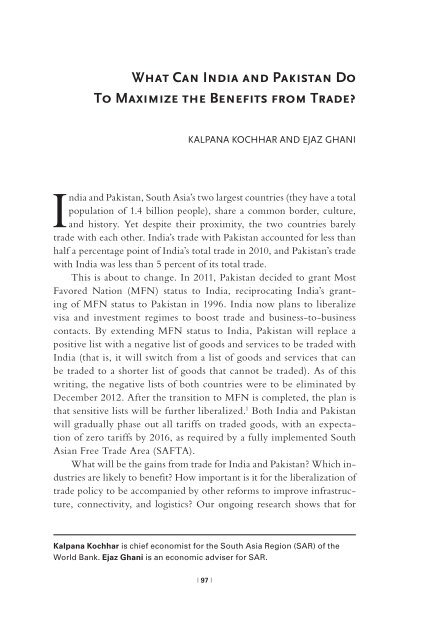You also want an ePaper? Increase the reach of your titles
YUMPU automatically turns print PDFs into web optimized ePapers that Google loves.
What Can <strong>India</strong> and <strong>Pakistan</strong> Do<br />
To Maximize the Benefits from <strong>Trade</strong>?<br />
KALPANA KOCHHAR AND EJAZ GHANI<br />
<strong>India</strong> and <strong>Pakistan</strong>, South Asia’s two largest countries (they have a total<br />
population of 1.4 billion people), share a common border, culture,<br />
and history. Yet despite their proximity, the two countries barely<br />
trade with each other. <strong>India</strong>’s trade with <strong>Pakistan</strong> accounted for less than<br />
half a percentage point of <strong>India</strong>’s total trade in 2010, and <strong>Pakistan</strong>’s trade<br />
with <strong>India</strong> was less than 5 percent of its total trade.<br />
This is about to change. In 2011, <strong>Pakistan</strong> decided to grant Most<br />
Favored Nation (MFN) status to <strong>India</strong>, reciprocating <strong>India</strong>’s granting<br />
of MFN status to <strong>Pakistan</strong> in 1996. <strong>India</strong> now plans to liberalize<br />
visa and investment regimes to boost trade and business-to-business<br />
contacts. By extending MFN status to <strong>India</strong>, <strong>Pakistan</strong> will replace a<br />
positive list with a negative list of goods and services to be traded with<br />
<strong>India</strong> (that is, it will switch from a list of goods and services that can<br />
be traded to a shorter list of goods that cannot be traded). As of this<br />
writing, the negative lists of both countries were to be eliminated by<br />
December 2012. After the transition to MFN is completed, the plan is<br />
that sensitive lists will be further liberalized. 1 Both <strong>India</strong> and <strong>Pakistan</strong><br />
will gradually phase out all tariffs on traded goods, with an expectation<br />
of zero tariffs by 2016, as required by a fully implemented South<br />
Asian Free <strong>Trade</strong> Area (SAFTA).<br />
What will be the gains from trade for <strong>India</strong> and <strong>Pakistan</strong>? Which industries<br />
are likely to benefit? How important is it for the liberalization of<br />
trade policy to be accompanied by other reforms to improve infrastructure,<br />
connectivity, and logistics? Our ongoing research shows that for<br />
Kalpana Kochhar is chief economist for the South Asia Region (SAR) of the<br />
World Bank. ejaz Ghani is an economic adviser for SAR.<br />
| 97 |


